FESTIVALPROGRAM BLOG
EXCERPTS IN GERMANSIMPLICITY - the art of complexity - ARS ELECTRONICA 2006 - Festival für Kunst, Technologie und Gesellschaft - Linz, Do 31. August – Di 5. September
29
Aug
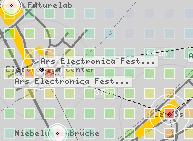 © denCity.net
© denCity.net © denCity.net
© denCity.net
just a few days left until the festival and we finally opened denCity.net up for Linz.
there is a map with all the festival-relevant sites that waits to be filled with tags.
the happy ones with a compatible mobile camera phone can install GLASS, shoot denCity.net tags and get augmented!
looking forward to seeing you in Linz!
kai&philipp
denCity.net
denCity.net AE festival map
download GLASS from activeprint
5
Aug
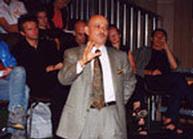 © Sabine Starmayr
© Sabine Starmayr
Jason Kottke (US) is a well-known American blogger and former Webdesigner. He created the enormously popular Silkscreen font that is widely used in the field of Web design. In March 1998, Kottke launched his blog that has gone on to become one of the highest-ranked personal sites in the blogging ecosystem.
Gary Chang (CN) founded his company EDGE in 1994. His commercial commissions include clubhouse, retail space, hotel, restaurant, office, yacht and aircraft interiors as well as product designs. The Suitcase House at the Commune by the GreatWall (a luxury hotel in China), the Kung-Fu Teaset for Alessi, and his own apartment in Hong Kong are his
best-known design projects.
Olga Goriunova (RU) is an artist, art scholar, co-organizer of the
Read_Me Festival and co-founder of the runme.org website.
Eric Yeatman (US) has been a member of the academic staff of the Imperial College in London since 1989. He is currently professor of microengineering and assistant director of the college’s research group in that field. He has been manager of two large EU research collaborations, and principal or co-investigator on 12 research council and several industry-supported projects, and has published more that 60 scholarly papers on materials for integrated optics as well as on
microfabrication and radio frequency MEMS.
Fr/Fri
1. 9.
15:00 - 18:00
Brucknerhaus,Mittlerer Saal
Simplicity Symposium II
15:00 - 15:15 Intro John Maeda
15:15 - 15:45 Jason Kottke
15:45 - 16:15 Gary Chang
16:15 - 16:30 Pause
16:30 - 17:00 Olga Goriunova
17:00 - 17:30 Eric Yeatman
17:30 - 18:00 Diskussion
Moderator: John Maeda
5
Aug
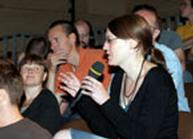 © rubra
© rubra
Sam Hecht (UK) studied industrial design at Central St. Martin’s College of Arts and Design and received his degree in industrial design from the Royal College of Art in London. He has been the recipient of numerous prizes, and his list of clients includes Muji.
Walter Bender (US) heads the Gray Matters working group that deals with technology's impact on an increasingly elderly population. He is member of the MIT Media Lab’s SIMPLICITY Project, Things That Think and the Digital Life Consortium. Bender is currently president of the software and content division of One Laptop Per Child, a non-profit organization that is developing a technology designed to revolutionize how the world’s children are educated.
Paola Antonelli (US) is curator of the architecture and design department at the Museum of Modern Art (MoMA) in New York. Her “Mutant Materials in Contemporary Design” exhibition (1995) garnered high praise. Her latest offering “SAFE: Design Takes on Risk” (2005) deals with objects that aim to protect our bodies and souls.
Hugh Herr (US) is Associate Professor of Media Arts and Sciences at the MIT Media Lab. His research activities concentrate on ways in which principles derived from muscle mechanics, neuronal control and human biomechanics can be applied to the development of biomimetic robots and rehab devices.
Fr/Fri
1. 9.
10:30 - 13:30
Brucknerhaus,Mittlerer Saal
Simplicity Symposium I
10:30 - 10:45 Intro John Maeda
10:45 - 11:15 Sam Hecht
11:15 - 11:45 Walter Bender
11:45 - 12:00 Pause
12:00 - 12:30 Paola Antonelli
12:30 - 13:00 Hugh Herr
13:00 - 13:30 Diskussion
Moderator: John Maeda
4
Aug
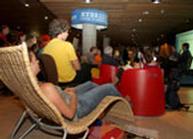 © rubra
© rubra
The make-it-simple workshops will highlight this year's e-lobby kitchen. Concepts and results that emerge from the workshops will be presented and thrashed out.
Fr/Fri 1.9. 12:00 - 14:00:
Andreas Hirsch will chair the follow-up discussion after the first session of the Simplicity Symposium.
Mo/Mon 4. 9. 12:00 - 14:00
Günter Reisinger will present the Ludwig Boltzmann Institute’s netzpioniere.at” project. Plus: spontaneous elaborations.
Di/Tue 5. 9. 18:00 - 19:00
Making of Strawinsky, Susanne Scheel, Horst Hörtner, Klaus Obermayer
electrolobby kitchen
1
Aug
Conferences | posted by Maria Hieslmayr | at 13:15:00
Simplicity Symposium curated by John Maeda (US)
 ©
©
A simple life. Mankind’s constant search for simplicity is unavoidably connected with the boredom that rears its ugly head as soon as this wish is fulfilled and complexity once again begins flaunting its charms. This dialectic of simplicity and complexity has harried human beings in all areas of life.
Thus, in order to even be able to deal with the world of the computer, we have to just accept adegree of complexity that we are unable to definitively grasp.
A stellar lineup of speakers will elaborate on the many different aspects of simplicity - and complexity no doubt as well. How do we live? How will we be living? What do we fear? What do we yearn for? Together, we'll organize, reduce and synthesize a catalog of knowledge upon this podium of trust, and hope that, as a result, everyone taking part will be able to make his/her own choice of a path to simplicity or complexity.
This fall, John Maeda will be publishing a book that deals with “The Ten Laws of Simplicity.” For two years in Maeda’s simplicity blog (http://weblogs.media.mit.edu/SIMPLICITY), the contents of this publication have been at the focal point of a public discussion that will now flow into the Simplicity Symposium, whereby one area of particular emphasis will no doubt be the issue of appropriate design strategies to allow simplicity and complexity to converge.
Fr/Fri
1. 9.
10:30 - 13:30
Brucknerhaus,Mittlerer Saal
Simplicity Symposium I
Fr/Fri
1. 9.
15:00 - 18:00
Brucknerhaus,Mittlerer Saal
Simplicity Symposium II
25
Jul
Conferences | posted by Maria Hieslmayr | at 15:57:00
Forum III – Computer Animation / Visual Effects
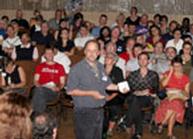 © rubra
© rubra
The prize winners in the "Computer Animation / Visual Effects" category:
Jan Bitzer, Ilija Brunck, Tom Weber/ Filmakademie Baden Württemberg
DE) - 458nm - Golden Nica
Daniel Nocke (DE) - Kein Platz für Gerold
Jun Awazu (JP) - NEGADON: The Monster from Mars
Participants of the Forum:
Mark Dippé (US), Juryvertretung
Jan Bitzer, Ilija Brunck, Tom Weber (DE)
Daniel Nocke (DE)
Jun Awazu (JP)
25
Jul
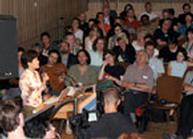 © rubra
© rubra
The prize winners in the "Digital Musics"category:
Eliane Radigue (FR) - L’île re-sonante – Golden Nica
Joe Colley (US) - psychic stress soundtracks
Kaffe Matthews (UK) / Annette Works (UK) - Sonic Bed_London
Participants of the Forum:
Rob Young (UK), Juryvertretung
Eliane Radigue (FR)
Joe Colley (US)
Kaffee Matthews (UK)
24
Jul
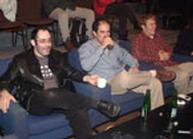 © Sabine Starmayr
© Sabine Starmayr
The prize winners in the "Interactive Art" category:
Paul DeMarinis (US) - The Messenger - Golden Nica
Zachary Lieberman (US) - drawn
Evan Roth, James Powderly and the agents of the G.R.L.
(Eyebeam OpenLab, US) - Graffiti Research Lab
Participants of the Forum:
Karin Ohlenschläger (ES), Juryvertretung
Erkki Huhtamo (US / FI)
Zachary Lieberman (US)
Evan Roth, James Powderly (US)
11:45 – 12:30 Artist Speech: John Maeda
24
Jul
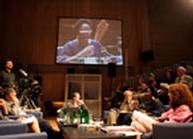 © rubra
© rubra
A themed collaboration of Ars Electronica and Ö1 matrix, curated by Sonja Bettel and Ina Zwerger
Forum IV - Digital Communities
Access to all areas
Monday, 4.9.2006: 10:30 AM - 01:30 PM
Communications technologies can provide access to information, expand the latitude of human action and bring people together. But they can also act as a hindrance. Incomprehensible menus, unergonomic keyboards, tiny typefaces, cryptic functions, the lack of platform diversity—the list of obstacles that make using technology more difficult or even impossible is a long one. How do the Internet and other technologies have to be set up so that all people—regardless of their physical and technical endowments—are able to enjoy unrestricted use? What’s preventing developers from implementing findings about usability and barrier-free design? Which new technologies can, in spite of their complexity—or, perhaps, precisely because of it—simplify everyday life?
Winners in the Prix Ars Electronica’s Digital Communities category present their projects and discuss accessibility and usability with experts in the field and those who are concerned with or disadvantaged by the absence of these qualities.
Moderation: Ina Zwerger, Sonja Bettel (Ö1 Matrix)
In cooperation with Ö1 Matrix
Antoni Abad - canal*ACCESSIBLE - Golden Nica http://www.zexe.net/barcelona
Codecheck.ch - Codecheck
Silvana Lemos de Almeida - PROYECTO CYBERELA – RADIO TELECENTROS http://www.cemina.org.br
Präsentation:
Andreas Hirsch (AT)
Antoni Abad (ES)
Roman Bleichenbacher (CH)
Silvana Lemos de Almeida (BR)
With: Klaus Miesenberger (AT), Paul Lukowicz (AT), Manfred Tscheligi (AT), Michaela Braunreiter (AT), Antoni Abad (ES), Eva Wohlgemuth (AT)
Forum V – Net Vision
Monday, 4.9.2006: 3 PM - 5 PM
The prize winners in the "Net Vision" category:
exonemo (JP) - The Road Movie - Golden Nica
Michael Stadler (AT) - Tsunami Harddisk Detector
Wayne Clements (UK) - un_wiki
Präsentation:
Eva Wohlgemuth (Jury)
Exonemo (JP)
Michael Stadler (AT)
Wayne Clements (UK)
Participants of the Forum:
Antoni Abad (ES)
Sonja Bettel (AT)
Roman Bleichenbacher (CH)
Michaela Braunreiter (AT)
Wayne Clements (UK)
Silvana Lemos de Almeida (BR)
exonemo (JP)
Paul Lukowicz (AT)
Klaus Miesenberger (AT)
Michael Stadler (AT)
Manfred Tscheligi (AT)
Eva Wohlgemuth
Ina Zwerger (AT)
23
Jul
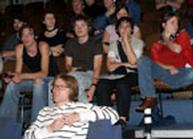 © rubra
© rubra
At which venues of artistic production does art enter into a dialog with media, science and technology? What can these locations tell us about the unique aspects of working in media art? How are they connected to various scientific, academic, military, economic and other contexts? What is the source of the legitimacy ascribed nowadays to the existence of a separate discourse and special institutions dedicated to media art? What are the specific features of these places, and where might their future lie?
Panel discussion organized by the Ludwig Boltzmann Institute Media.Art.Research in cooperation with re:place 2007, The Second International Conference on the Histories of Media Arts, Sciences and Technologies
With Dieter Daniels (AT/DE), Andreas Broeckmann (DE), Gunalan Nadarajan (SG/US), Edward Shanken (US), et al.
Andreas Broeckmann (DE)
Dieter Daniels (DE)
Gunalan Nadarajan (PT)
Edward A. Shanken (US)
23
Jul
 © rubra
© rubra
The Upgrade! is an international network of gatherings concerning art, technology and culture. As an emerging network of autonomous nodes committed to bridging cultural divides, The Upgrade! operates along an axis of simplicity, by sustaining a monthly gathering format, and as a space for artists to present and share their work. As an international organisation, the network engages complex problems as it struggles to find a model for decision-making, representation, funding, organisation and growth within trusted community-based collaborations. The Upgrade! began in 1999 with a regular gathering in New York City organised by Yael Kanarek. Upgrade! New York partnered with Eyebeam in 2000, and in 2004 The Upgrade went international with Vancouver and Montreal, followed by over a dozen worldwide locations in 2005 (and growing!). The first Upgrade! International Gathering was held in September 2005 in NYC at Eyebeam, with representatives from each node, and the second will be held in Oklahoma City, USA, from November 30th–December 3rd, 2006.
www.theupgrade.net
Current Nodes: AMSTERDAM (Lucas Evers / Nat Muller); BOSTON (Jo-Anne Green); CARACAS (Yucef Merhi / Deborah Mizrahi); CHICAGO (Tiffany Holmes / Lincoln Schatz); ISTANBUL (Emre Erkal / Erhan Muratoglu / Basak Senova / NOMAD); JOHANNESBURG (Christof Doherty / Nathaniel Stern); LISBON (Luís Silva); MONTREAL (Anik Fournier / Sophie Le-Phat Ho / tobias c. van Veen) _ MUNICH (Tamiko Thiel); NEW YORK (Yael Kanarek / Jesse Pearlman Karlsberg / Liz Slagus); OKLAHOMA CITY (Adam Brown); SALVADOR (José Balbino / midiatatica.org / Oitininha); SCOTLAND (New Media Scotland); SEOUL (Suhjung Hur); SKOPJE (Antonio Dimitrov / Elena Veljanovska); SOFIA (Petko Dourmana / Ivaylo Ivanov / Yana Kostova / Yovo Panchev); TEL AVIV / JERUSALEM (Salamanca / Mushon Zer-Aviv); VANCOUVER (Kate Armstrong); WELLINGTON (Marcia Lyons)
Future Nodes: ATHENS (Daphne Dragona); BELGRADE (Maja Ciric / Jasmina Maric / Zana Poliakov); BERLIN (Public Art Lab); LIVERPOOL (N.N.); PARIS (Incident.net); VIENNA (Ursula Hentschlaeger / Zelko Wiener)
22
Jul
![]() © rubra
© rubra
The urban domain is being infrastructurally upgraded into a multimedia environment as digitization makes its physical mark on the cityscape itself.
Architecture is being endowed with medial qualities and equipped with everything from telematic furnishings to location-based services, elements that constitute interfaces between virtual and material spheres of communication. Creative confrontations beyond the realm of advertising messages and décor betoken growing consciousness of the mediatization of society.
The results of these encounters integrate themselves into their environment as subtle interventions, but also as the fulfillment of tasks on a mundane agenda. Media art’s manifesting itself beyond the confines of the museum-exhibition context as a component of a piece of architecture or in the form of telematic environmental design has been accompanied by the emergence of a new quality being exhibited by installations.
A criterion of particular relevance to this category of (in many cases interactive) projects is user involvement in a way that is as intuitive as possible: a mode of functioning that proceeds as a matter of course without in any way diminishing the expressiveness of the project itself.
At the 2006 Pixelspaces Conference, practitioners in this field will participate in an open discourse focusing on the challenges that (media) designers see themselves confronted with as a result of the emergence of the “real-time city.”
21
Jul
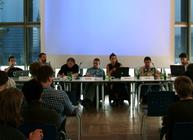 © Sabine Starmayr
© Sabine Starmayr
Over the last 10 years, completely new preconditions have become operative in the media with respect to information development and the possibilities of actively expressing and disseminating opinions. The media world’s complexity has increased exponentially through the emergence of network media like weblogs and wikis.
Lisl Ponger (AT)
Johannes Schnizer (AT)
12
Jun
Conferences | posted by Wolfgang Bednarzek | at 17:00:00
Recommended Reading: “Mobile Interaction Design”
What more and more people are now demanding from their high-tech paraphernalia is that it be easy to use—a key aspect of “Simplicity.” Matt Jones and Gary Marsden have been dealing intensively with this issue and have documented their experiences in the book “Mobile Interaction Design.” In it, their focus is more on human needs, wishes and capabilities than on technological parameters and preconditions.
The book elaborates on the key factors that make for good interaction design in the field of mobile technology in a way that is enlightening, lucid and reader-friendly. Its case studies and “maneuver critiques” of current high-tech gear are easy to read and deliver effective tools for crafting the user-centered applications of tomorrow.
In the words of the authors: “This book is about shifting the mobile design perspective away from ‘smart’ phones, to people who are smart, creative, busy, or plain bored. Our aim is to help you to overcome the frustrations of the previous disappointing handheld ‘revolution’ by providing the billions of potential mobile users with future products and services that can change their (or even the) world.”
12
Jun
A piece of high-tech equipment like an mp3 player should ideally be able to get across what it’s designed to do and how to operate it just as simply as a wedge, a sledgehammer or a saw does. You have the device in front of you, consider its form, try it out and, after a couple of attempts at most, you have all of its features down pat.
Blanket statements like this can get designers, programmers and engineers really worked up. Their critique might well maintain that comparing a highly complex instrument that represents the culmination of thousands of technological advances that this civilization has brought forth—from gramophone cylinders and shellac discs to radio and all the way to fiberglass cables, the PC and digitization—with a simple wedge is pretty farfetched to say the least.
But even companies like Microsoft, Intel and Adobe are increasingly coming around to this way of thinking. What other explanation is there for the fact that their efforts to achieve design breakthroughs are concentrating on collaboration with ethnologists and anthropologists? After all, these are precisely the fields of social science that deal with mankind’s interaction with tools. Here, the focus is on intuition, which is controlled by a number of different cultural factors and which enables us, among other things, to swiftly grasp how a particular object can be employed.
“Design ethnography” is the techno-speak term that has been coined to describe these scholarly disciplines that have been stripped down to their practical essentials and placed in the service of information technology.
We can only hope that a holistic approach that takes human beings and their overall cultural settings into account doesn’t get lost in the shuffle here.
In any case, when you consider the fact that ethnographic teams have been developing guidelines and generating studies for major players in the IT industry for at least five years, the results that this has yielded to date appear to be pretty meager.
More info and interesting articles on this topic are available online in “gotoreport” at www.gotomedia.com.
Blog Authors:
Maria Hieslmayr Cornelia Sulzbacher Wolfgang Bednarzek Gerda Hinterreiter Didi Offenhuber Beta Lounge Artists David Cuartielles Sonja Meller StWSt denCity.net
Search:
Categories:
Conferences Animation Festival Events, Concerts & Performances Campus Exhibitions e-lobby Prix Ars Electronica
Recent Posts:
Photographs of the 2006 Festival Media lab thanks! Ars Electronica Center FM4 Live from Ars Electronica in Linz
Archives:
Posts 20 - 0


